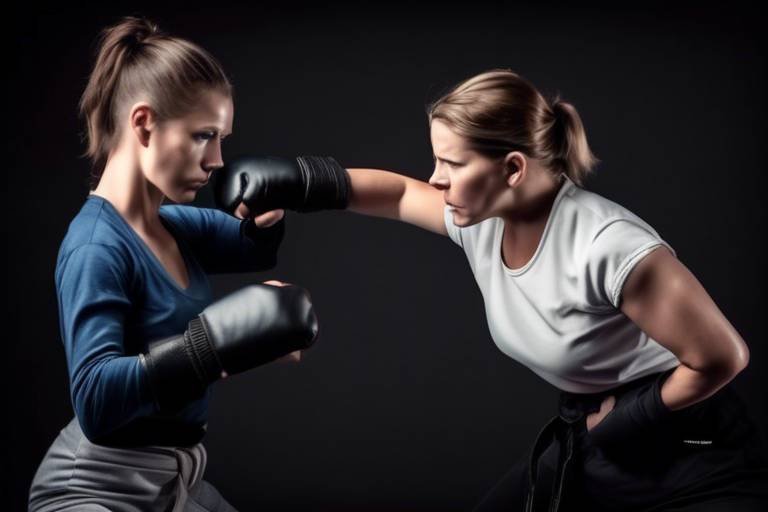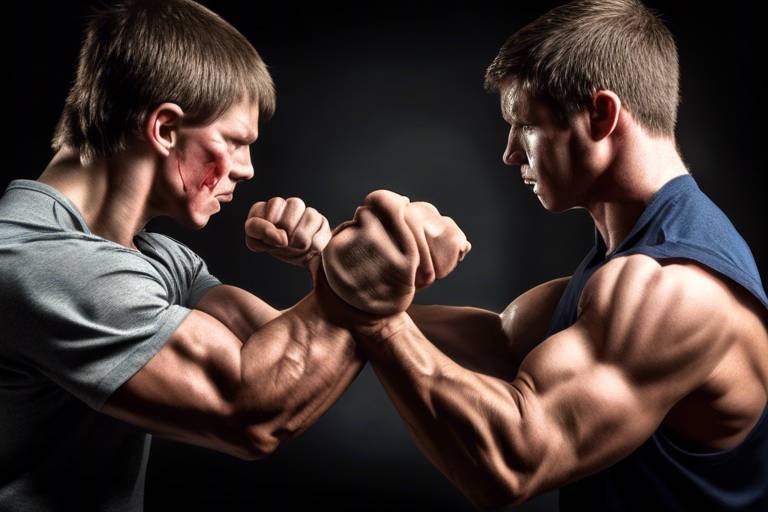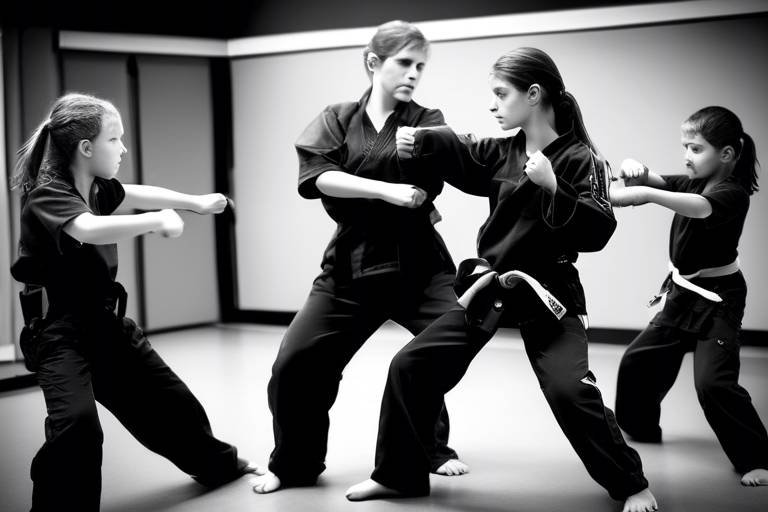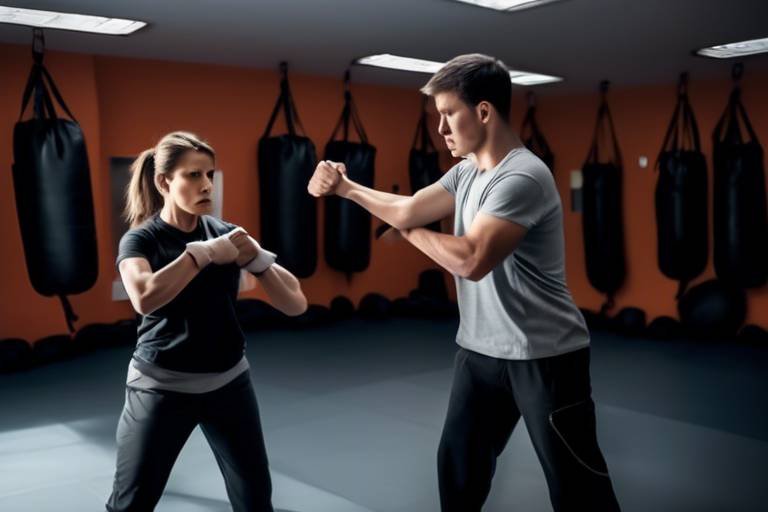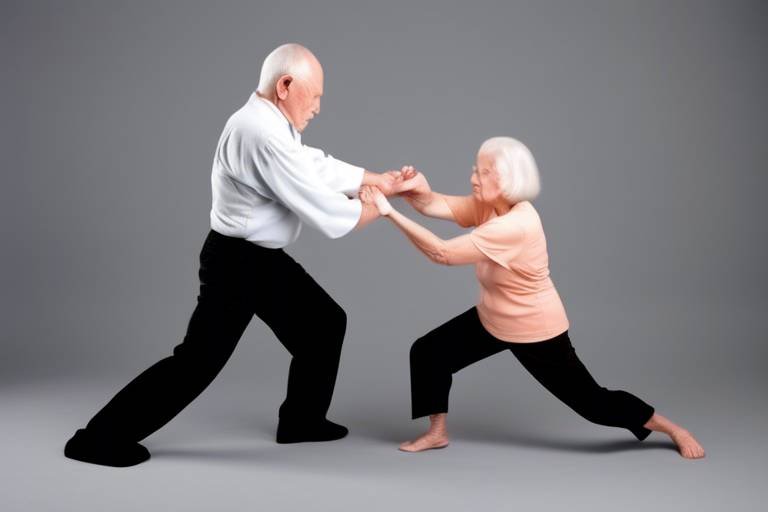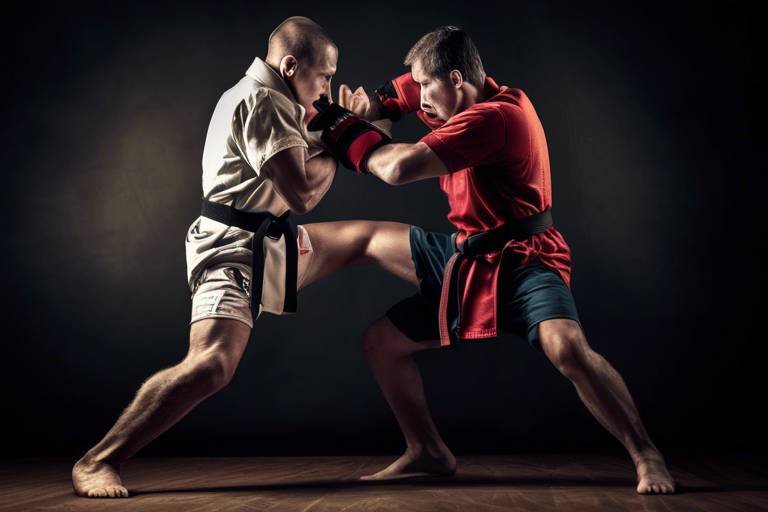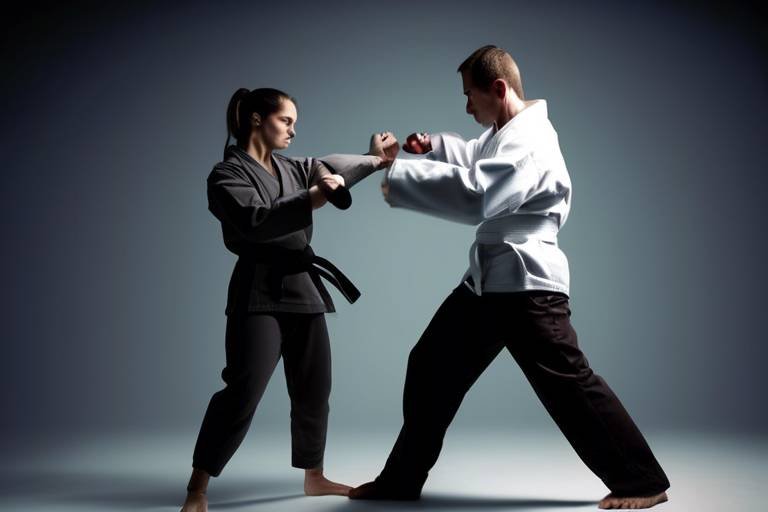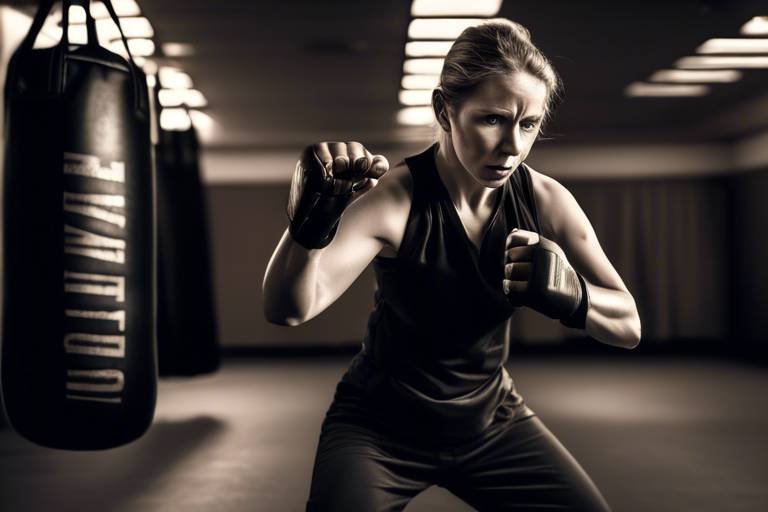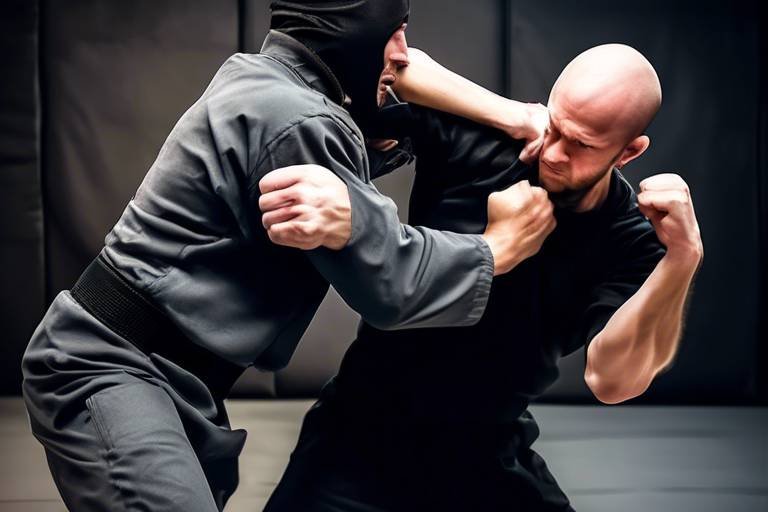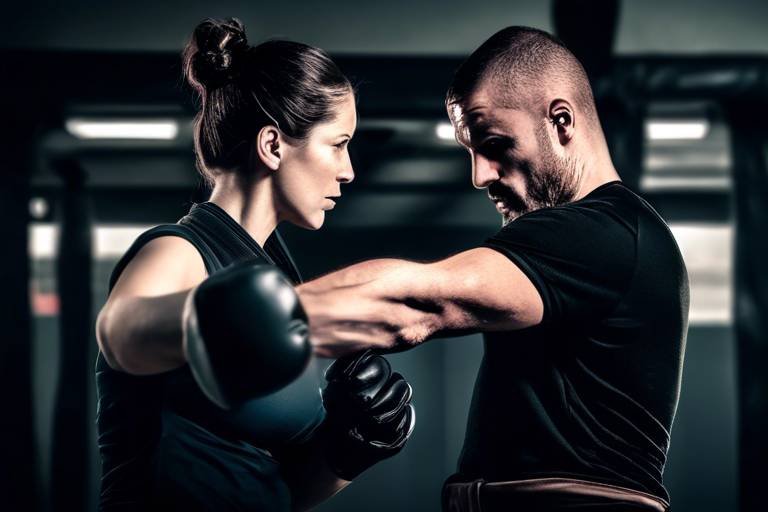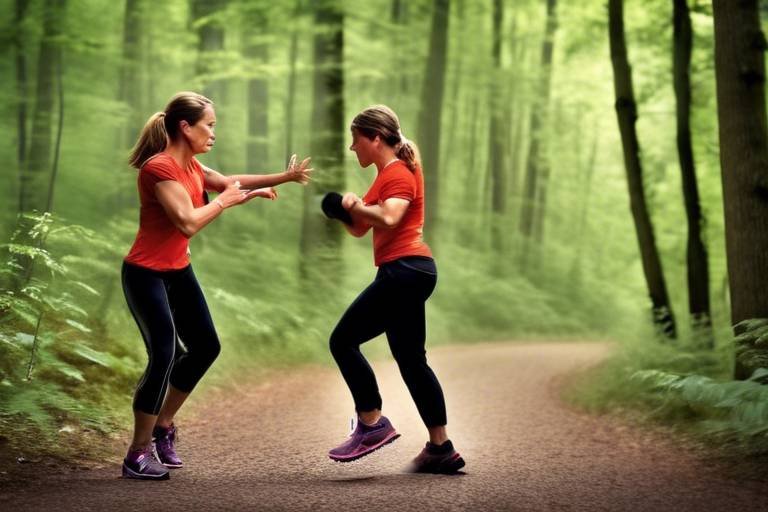Selecting the Type of Self-Defense Training to Start With
When it comes to self-defense, the options can feel overwhelming. With so many different training styles available, how do you choose the one that suits your needs? It's like walking into a candy store and trying to pick just one treat—there's a flavor for everyone! In this article, we will explore various self-defense training options, helping you identify the most suitable type based on your personal goals, circumstances, and preferences. Whether you’re looking to build confidence, get fit, or simply learn how to protect yourself, there’s something out there for you. Let's dive into the world of self-defense and discover the benefits and features of each training style!
Self-defense is not just about throwing punches or grappling on the ground; it encompasses a variety of techniques and strategies designed to protect oneself from harm. Imagine being in a situation where you feel threatened—having the right skills can mean the difference between safety and danger. Knowing the fundamental principles of self-defense helps you make informed choices about the type of training that will benefit you the most. It’s essential to understand that self-defense is not solely about physical prowess; it also involves mental awareness and the ability to assess situations critically.
There are numerous self-defense training styles available, each offering unique benefits and focusing on different aspects of self-defense. Whether you're a beginner or have some experience, understanding these options can guide you toward the right choice. Below, we’ll explore a few popular training styles:
Martial arts, such as karate and judo, provide a structured approach to self-defense. Participants learn techniques for striking, grappling, and self-control, promoting not only physical fitness but also mental discipline. Think of martial arts as a journey; each class is a step toward mastering your body and mind. The discipline and respect instilled in these practices can transform not just your fighting skills but your overall outlook on life.
Karate emphasizes striking techniques, including punches, kicks, and blocks. It's like learning a new language—each move is a word, and together they form a powerful sentence of self-defense. Training in karate not only develops self-defense skills but also fosters confidence, focus, and respect among practitioners. Many find it a popular choice because it builds a strong foundation for understanding personal safety while promoting a sense of community.
Judo focuses on grappling and throwing techniques, teaching individuals how to use an opponent's force against them. This art promotes physical conditioning and strategic thinking, making it effective for self-defense in close-quarters situations. Imagine being able to turn your adversary's energy into your advantage—judo empowers you to do just that! It’s a fantastic choice for those who prefer a more tactical approach to self-defense.
Krav Maga is a practical self-defense system developed for real-life situations. Emphasizing instinctive movements and quick responses, it equips individuals with the skills needed to defend against various threats effectively. Think of it as a survival toolkit; it’s designed to prepare you for the unexpected. If you're looking for a no-nonsense approach that focuses on real-world scenarios, Krav Maga might be the right fit for you.
Personal safety courses often focus on awareness, prevention, and avoidance strategies rather than physical confrontation. These courses empower individuals with knowledge and skills to navigate potentially dangerous situations safely. Imagine walking through your neighborhood with confidence, knowing you have the tools to stay safe. This proactive approach is essential for personal safety and can significantly reduce the risk of confrontation.
Situational awareness training teaches individuals to recognize and assess their environment, enhancing their ability to avoid danger. This is not just about being alert; it’s about developing a sixth sense for safety. By understanding your surroundings, you can spot potential threats before they escalate, making this training invaluable for anyone looking to boost their personal safety.
Conflict resolution courses focus on verbal de-escalation techniques and negotiation strategies. Learning these skills can help individuals avoid physical confrontations and resolve disputes peacefully, promoting a safer community overall. Think of it as having a toolbox filled with communication skills; these tools can help you navigate tricky situations without resorting to violence. In a world where misunderstandings are common, these skills are essential for maintaining harmony.
- What is the best self-defense training for beginners? The best training often depends on personal preferences, but many beginners find martial arts like karate or judo to be a great start.
- How long does it take to become proficient in self-defense? Proficiency varies by individual and training type, but consistent practice over several months can yield significant improvements.
- Is self-defense training effective for women? Absolutely! Self-defense training is highly effective for individuals of all genders, providing skills and confidence to handle various situations.

Understanding Self-Defense
Self-defense is more than just a physical response to an attack; it’s a comprehensive approach to personal safety that encompasses various techniques and strategies aimed at protecting oneself from harm. Imagine walking down the street and suddenly feeling the hair on the back of your neck stand up. That instinctual feeling is your body’s way of alerting you to potential danger. Understanding self-defense means recognizing these instincts and knowing how to act upon them effectively.
At its core, self-defense is about empowerment. It’s about taking control of your safety and being prepared for unexpected situations. Whether you’re a college student navigating campus life, a professional commuting to work, or a parent picking up your kids from school, having self-defense knowledge can significantly enhance your confidence and peace of mind. But what does it truly entail?
Self-defense training can be categorized into two main aspects: physical techniques and awareness strategies. The physical techniques involve learning how to defend yourself against an attacker, while awareness strategies focus on recognizing potential threats before they escalate. This dual approach is essential for effective self-defense.
To illustrate, let’s break down the fundamental principles of self-defense:
- Awareness: Being aware of your surroundings is the first line of defense. It’s about tuning into your environment and noticing anything that feels off.
- Prevention: The best fight is the one you avoid. Learning how to de-escalate situations or remove yourself from them can prevent confrontation.
- Physical Techniques: If avoidance isn’t possible, having the skills to physically defend yourself is crucial. This includes knowing how to strike, block, and escape holds.
When considering self-defense training, it’s essential to reflect on your personal goals and circumstances. For instance, if you’re seeking a structured environment that promotes fitness and discipline, martial arts might be your best bet. Alternatively, if you want practical skills for real-life scenarios, Krav Maga could be more suitable. Each approach has its unique benefits and caters to different needs.
Ultimately, understanding self-defense is about more than just learning how to fight; it’s about cultivating a mindset of safety and awareness in your daily life. It’s about being prepared to protect yourself and those you care about, whether that means physically defending against an attacker or simply avoiding a dangerous situation altogether. So, are you ready to take the first step in your self-defense journey?
Here are some common questions regarding self-defense training:
- What is the best self-defense training for beginners? It often depends on personal preference, but many find that basic martial arts classes or personal safety courses are excellent starting points.
- How long does it take to become proficient in self-defense? Proficiency varies by individual and training style, but consistent practice over several months can lead to significant improvements.
- Can self-defense training help with confidence? Absolutely! Many practitioners report increased confidence and awareness after completing self-defense training.

Types of Self-Defense Training
When it comes to self-defense training, the options can feel overwhelming. With various styles available, each boasting its own unique benefits and approaches, how do you choose the right one for you? First, it's essential to understand that self-defense training is not a one-size-fits-all solution. Your choice should reflect your personal goals, physical abilities, and even your lifestyle. Whether you're looking to build confidence, improve physical fitness, or learn practical self-defense skills, there's something out there for everyone.
Let's dive into some of the most popular types of self-defense training:
- Martial Arts: This broad category includes various disciplines like karate, judo, and taekwondo. Each martial art has its own philosophy and techniques, making it crucial to explore which resonates with you.
- Krav Maga: Known for its focus on real-world scenarios, Krav Maga teaches instinctive movements and practical techniques that can be applied in various situations.
- Personal Safety Courses: These courses often emphasize awareness and avoidance strategies rather than physical confrontation, empowering individuals with the knowledge to navigate potentially dangerous situations.
In the world of self-defense, understanding the different types of training can help you make an informed decision. For instance, martial arts like karate and judo not only teach you how to defend yourself but also instill values like respect, discipline, and focus. On the other hand, Krav Maga is more about practical application, allowing you to react quickly in high-pressure situations. Meanwhile, personal safety courses prioritize awareness and prevention, which can be just as crucial as physical skills.
Ultimately, the best self-defense training for you will depend on your individual needs and circumstances. Are you looking for a rigorous workout that also equips you with self-defense skills? Martial arts might be your best bet. If you're seeking a straightforward approach to handling real-life threats, consider Krav Maga. Or if your goal is to enhance your awareness and avoid conflict altogether, personal safety courses could be the way to go.
As you explore your options, don't forget to consider factors like class availability, instructor qualifications, and the overall environment of the training facility. The right training can not only improve your self-defense skills but also boost your confidence and peace of mind. Remember, the journey to self-defense mastery is a personal one, and choosing the right path is the first step toward empowerment.

Martial Arts
Martial arts represent a diverse and rich tapestry of disciplines that not only teach self-defense but also promote overall well-being. When you step into a dojo or training hall, you're not just learning how to punch or kick; you're embarking on a journey that enhances your physical fitness, mental resilience, and personal discipline. Think of martial arts as a holistic approach to self-defense—where each technique learned is like a tool in a toolbox, ready to be used when the need arises.
One of the most appealing aspects of martial arts is the structured environment it provides. In classes, you’ll often find a blend of rigorous physical training and philosophical teachings. This combination fosters a sense of community among practitioners, creating bonds that go beyond just learning to defend oneself. The camaraderie found in martial arts classes can be likened to a family, where everyone supports each other in their individual journeys.
As you dive deeper into martial arts, you’ll discover various styles, each with its unique flavor. Here are a few popular forms:
- Karate: Known for its powerful strikes, karate emphasizes precision and control. Practitioners learn to harness their energy effectively, developing not just their bodies but also their minds.
- Judo: This art focuses on leverage and technique rather than brute strength. Judo teaches you how to use an opponent's momentum against them, making it ideal for self-defense in tight situations.
- Tai Chi: Often viewed as a form of moving meditation, Tai Chi enhances flexibility and balance while promoting inner peace. It’s not just about fighting; it’s about finding harmony within oneself.
In addition to physical techniques, martial arts instill valuable life skills. For instance, the discipline required to master a kata (a sequence of movements) translates into perseverance in everyday life. The respect shown towards instructors and fellow students fosters a sense of humility and accountability. Imagine walking into a room filled with people who share the same goal of bettering themselves; it’s motivating and inspiring!
Moreover, martial arts training can be an excellent way to relieve stress. After a long day, there’s nothing quite like hitting a punching bag or sparring with a partner to let off steam. It’s a physical outlet that not only builds strength but also clears your mind. In essence, martial arts serve as both a mental and physical sanctuary, where you can escape the pressures of daily life.
In conclusion, martial arts offer a comprehensive approach to self-defense that encompasses physical, mental, and emotional growth. Whether you’re looking to learn self-defense, improve your fitness, or find a supportive community, martial arts can be a transformative experience. So, why not give it a try? You might just discover a passion that changes your life!
Q1: Do I need to be fit to start martial arts?
A: Absolutely not! Martial arts are designed for individuals of all fitness levels. Instructors will help you progress at your own pace.
Q2: How long does it take to become proficient in martial arts?
A: Proficiency varies from person to person. With consistent practice, many people see significant improvements within a few months.
Q3: Is martial arts training safe?
A: While there is always some risk involved in physical activities, martial arts training emphasizes safety and control. Proper instruction and protective gear can minimize risks.
Q4: Can martial arts help with self-confidence?
A: Yes! As you learn new skills and techniques, you’ll likely find an increase in self-confidence both on and off the mat.

Karate
Karate is not just a martial art; it's a way of life that combines physical prowess with mental discipline. When you step onto the dojo floor, you're not merely learning to punch and kick; you're engaging in a transformative journey that builds confidence, enhances focus, and instills a deep sense of respect for yourself and others. The beauty of karate lies in its structured approach, where each movement is not only a technique but a lesson in self-control and perseverance.
One of the most appealing aspects of karate is its emphasis on striking techniques. Participants learn a variety of punches, kicks, and blocks, which are essential for effective self-defense. Imagine being able to defend yourself with a well-placed roundhouse kick or a powerful punch. These skills can be incredibly empowering, especially for those who may feel vulnerable in their everyday lives. But karate is more than just physicality; it's about developing mental strength and resilience. Each training session challenges you to push your limits, fostering a mindset that can help you tackle challenges both on and off the mat.
Moreover, karate is accessible to individuals of all ages and skill levels. Whether you're a child learning the basics or an adult looking to refine your skills, there's a place for everyone in the dojo. Classes are often structured to accommodate various experience levels, allowing beginners to learn at their own pace while still being challenged by more advanced practitioners. This inclusivity creates a supportive community where everyone encourages each other to grow and improve.
In addition to the physical benefits, karate also promotes important life skills. Through rigorous training, students learn the value of discipline and commitment. The journey to earn a new belt is not just about mastering techniques; it's about setting goals and working tirelessly to achieve them. This process cultivates a sense of accomplishment that extends beyond the dojo, influencing personal and professional aspects of life.
Furthermore, karate teaches vital self-defense skills that can be invaluable in real-world situations. While the primary focus is on developing technique and form, the ability to defend oneself can provide a significant sense of security. In a world where personal safety is a growing concern, knowing how to protect yourself can be a game changer. Karate equips you with the tools to respond effectively to threats, making it a practical choice for those seeking self-defense training.
In conclusion, karate is a multifaceted martial art that offers a wealth of benefits. From physical fitness to mental fortitude, the skills you acquire through karate training can have a profound impact on your life. So, if you're considering self-defense training, why not give karate a try? You might just find that it not only teaches you how to defend yourself but also helps you become the best version of yourself.
- What age is appropriate to start karate training? Karate can be practiced by individuals as young as 4 or 5 years old, with many dojos offering classes tailored for children.
- Do I need to be physically fit to start karate? No prior fitness level is required. Karate training will improve your fitness over time.
- Is karate effective for self-defense? Yes, karate teaches practical self-defense techniques that can be applied in real-life situations.
- How long does it take to earn a black belt in karate? The time varies, but it typically takes 3 to 5 years of consistent training to earn a black belt.

Judo
Judo is more than just a sport; it's a dynamic form of self-defense that emphasizes the art of using an opponent's strength against them. Originating from Japan, this martial art is built on principles that teach practitioners how to effectively grapple and throw their opponents, making it an incredibly effective choice for real-world self-defense scenarios. Imagine being able to take down a larger adversary simply by using their own momentum—this is the essence of Judo.
One of the key aspects of Judo is its focus on technique over brute strength. This makes it accessible to individuals of all sizes and strengths. Whether you're a petite individual or someone with a more robust build, Judo offers techniques that can be adapted to suit your physical capabilities. The training involves learning how to perform various throws, joint locks, and pins, which can be invaluable in a self-defense situation.
In addition to its physical techniques, Judo promotes mental discipline and strategic thinking. Practitioners are taught to remain calm under pressure, assess situations quickly, and make decisions that can turn the tide in their favor. This mental aspect is crucial not only in self-defense but also in everyday life, as it cultivates a sense of confidence and awareness that can help individuals navigate various challenges.
Furthermore, Judo training often involves sparring with partners, which allows practitioners to apply their skills in a controlled environment. This practice not only enhances physical fitness but also helps build a sense of community among participants. The dojo, or training hall, becomes a space where individuals can learn, grow, and support one another in their self-defense journeys.
For those considering Judo as a self-defense option, it's worth noting that the benefits extend beyond just learning how to defend oneself. The discipline fosters respect, humility, and perseverance, qualities that are essential in both martial arts and life. So, if you're looking for a way to boost your self-defense skills while also improving your overall fitness and mental resilience, Judo might just be the perfect fit for you!
- What is the difference between Judo and other martial arts? Judo focuses primarily on grappling and throwing techniques, whereas other martial arts may emphasize striking or weapon-based skills.
- Can anyone practice Judo? Absolutely! Judo is designed to be inclusive, and practitioners of all ages and fitness levels can participate and benefit from the training.
- How long does it take to get proficient in Judo? Proficiency in Judo varies by individual, but with regular practice, many people start to feel confident in their skills within a few months.

Krav Maga
is not just another self-defense system; it's a lifeline designed for real-world scenarios. Developed in Israel, this practical approach to self-defense focuses on instinctive movements and rapid responses, making it highly effective against various threats. Unlike traditional martial arts that may emphasize forms and rituals, Krav Maga cuts straight to the chase, teaching you how to survive in potentially dangerous situations. Imagine being cornered in a dark alley; would you rather have a choreographed routine in your mind or the ability to react swiftly and effectively? That's the essence of Krav Maga!
One of the standout features of Krav Maga is its emphasis on real-life situations. Training often includes scenarios that mimic actual attacks, whether from an assailant with a weapon or a sudden ambush. This immersive style of training prepares practitioners not just physically but mentally, instilling a sense of confidence that can only come from knowing you can handle yourself in a crisis. It's like learning to swim by jumping into the deep end instead of just splashing in the shallow water.
In Krav Maga, the focus is on efficiency and effectiveness. Techniques are designed to neutralize threats as quickly as possible, utilizing simple yet powerful moves. For instance, a common tactic is to target vulnerable areas of an attacker, such as the eyes, throat, or groin. This principle of targeting weak points makes Krav Maga accessible to individuals of all sizes and strengths. The idea is that a smaller person can defend themselves against a larger attacker by using technique and strategy rather than brute strength.
Moreover, Krav Maga training often incorporates elements of fitness and conditioning. Participants can expect to engage in rigorous workouts that not only build strength and endurance but also enhance agility and reflexes. This dual focus on self-defense and physical fitness means that practitioners leave each class feeling empowered, both mentally and physically. It's like hitting two birds with one stone—you're learning to protect yourself while also getting a fantastic workout!
Another critical aspect of Krav Maga is its adaptability. The techniques are continually refined based on feedback from real-world situations, ensuring that what you learn is relevant and effective. This dynamic nature of the training keeps it fresh and engaging, preventing the monotony that can sometimes come with traditional martial arts. So, if you're looking for a self-defense system that evolves with the times and prepares you for the unpredictability of life, Krav Maga might just be your best bet.
In summary, Krav Maga offers a comprehensive self-defense training option that is practical, efficient, and empowering. Whether you're a beginner or someone looking to enhance your self-defense skills, Krav Maga provides the tools and confidence to face any threat head-on. So, are you ready to take the plunge and equip yourself with the skills to defend your life?
- What is Krav Maga?
Krav Maga is a self-defense system developed in Israel that focuses on practical techniques for real-life situations.
- Is Krav Maga suitable for beginners?
Yes, Krav Maga is designed for individuals of all skill levels, including beginners.
- How does Krav Maga differ from traditional martial arts?
Krav Maga emphasizes real-world scenarios and instinctive responses, while traditional martial arts often focus on forms and rituals.
- What can I expect in a Krav Maga class?
Classes typically include physical conditioning, technique training, and scenario-based drills.

Personal Safety Courses
Personal safety courses are an essential resource for anyone looking to enhance their awareness and ability to navigate potentially dangerous situations. Unlike traditional self-defense training that often emphasizes physical confrontation, these courses focus on awareness, prevention, and avoidance strategies. The goal is to empower individuals with the knowledge and skills necessary to recognize threats before they escalate into physical altercations. Imagine walking through a crowded street, feeling confident and aware of your surroundings—that's the essence of what personal safety training aims to instill.
One of the key components of personal safety courses is situational awareness. This training teaches individuals to observe their environment critically, identifying potential dangers and assessing the behavior of those around them. By honing these skills, participants can better anticipate and avoid situations that could lead to confrontation. Think of it like being a detective in your own life, constantly gathering clues about your surroundings to stay one step ahead of any threats.
Additionally, personal safety courses often cover conflict resolution techniques. These skills are invaluable, as they provide individuals with the tools to de-escalate potential conflicts before they become physical. Imagine being in a heated argument where tensions are high; knowing how to use verbal de-escalation strategies can turn a volatile situation into a peaceful resolution. This not only protects you but also contributes to a safer community overall.
To give you a clearer picture of what personal safety courses encompass, here’s a brief overview of typical topics covered:
| Course Topic | Description |
|---|---|
| Situational Awareness | Training on recognizing and assessing your environment to avoid danger. |
| Conflict Resolution | Strategies for verbal de-escalation and negotiation to resolve disputes peacefully. |
| Self-Defense Basics | Fundamental techniques for protecting oneself in various situations. |
| Emergency Response | Guidance on what to do in case of an emergency, including contacting authorities. |
In conclusion, personal safety courses are not just about learning how to fight; they are about understanding your environment and equipping yourself with the tools to navigate it safely. By investing time in these courses, you can significantly enhance your ability to avoid dangerous situations and respond effectively when they arise. So, why wait? Take that first step towards a more secure and confident you!
- What is the duration of personal safety courses? Most courses range from a few hours to a full weekend, depending on the depth of training offered.
- Do I need any prior experience to take these courses? No prior experience is necessary; courses are designed for all skill levels.
- Are these courses suitable for children? Yes, many programs offer age-appropriate training for children and teens.
- Will I learn physical self-defense techniques? While the focus is on awareness and avoidance, basic self-defense techniques may also be included.

Situational Awareness
Situational awareness is like having a superpower in today's fast-paced world. It’s the ability to perceive your surroundings, understand the context of what’s happening, and anticipate potential threats before they escalate. Think of it as having a radar system that helps you navigate through life’s unpredictable challenges. Whether you're walking down a busy street, attending a social gathering, or even just sitting in a café, being aware of your environment can significantly enhance your personal safety.
Imagine you're in a crowded area, and suddenly you feel that something's off. Maybe someone is standing too close for comfort, or a group of people seems to be arguing loudly. Your gut feeling is your instinct kicking in, and if you have strong situational awareness, you can quickly assess the situation and decide on the best course of action. This could mean moving to a different location, alerting someone nearby, or simply staying calm and observing. The key is to recognize the signs of potential danger early on.
To develop situational awareness, consider the following strategies:
- Observe Your Surroundings: Take a moment to look around you. Who is nearby? Are there any unusual behaviors? The more you practice this, the sharper your instincts will become.
- Trust Your Instincts: If something doesn’t feel right, trust that feeling. Your subconscious often picks up on cues that your conscious mind might overlook.
- Stay Focused: In our digital age, distractions are everywhere. Keep your phone away and be present in the moment. This will help you notice details that could be crucial for your safety.
Moreover, understanding the psychology behind human behavior can also enhance your situational awareness. People often exhibit certain signs when they’re agitated or about to act aggressively. By familiarizing yourself with these warning signals, you can better prepare yourself to respond effectively. For instance, if someone is clenching their fists or avoiding eye contact, these could be red flags indicating a potential escalation.
Incorporating situational awareness into your daily routine can be a game-changer. It’s not just about being prepared for a confrontation; it’s about cultivating a mindset that prioritizes safety and preparedness. Just like a chess player anticipates their opponent's moves, being aware of your surroundings allows you to make informed decisions that could potentially save you from harm.
1. What is situational awareness?
Situational awareness is the ability to perceive your environment, understand the context of what’s happening, and anticipate potential threats. It's a crucial skill for personal safety.
2. How can I improve my situational awareness?
You can improve your situational awareness by practicing observation, trusting your instincts, and minimizing distractions in your environment.
3. Is situational awareness only important in dangerous situations?
No, situational awareness is beneficial in everyday life. It helps you navigate social interactions, avoid accidents, and make better decisions.
4. Can situational awareness be taught?
Yes, situational awareness can be developed through training and practice. Many personal safety courses include modules on enhancing this skill.

Conflict Resolution
Conflict resolution is an essential skill that can significantly enhance your ability to navigate through life's challenges. Imagine walking into a room filled with tension—perhaps a disagreement between friends or a heated discussion at work. Instead of letting the situation spiral out of control, having the right tools to de-escalate the conflict can make all the difference. Learning conflict resolution techniques not only helps you avoid physical confrontations but also fosters a more harmonious environment for everyone involved.
At its core, conflict resolution is about understanding the perspectives of all parties involved and finding a common ground. This process often involves effective communication and active listening. When you practice these skills, you become more aware of the emotions and motivations that drive people’s actions. It’s like being a detective, piecing together clues to solve a mystery. The better you understand the situation, the easier it is to find a resolution that satisfies everyone.
One of the most effective methods in conflict resolution is the use of verbal de-escalation techniques. These techniques include:
- Staying Calm: Maintain a calm demeanor to prevent the situation from escalating further.
- Using "I" Statements: Express your feelings and thoughts without blaming others. For example, say, "I feel upset when..." instead of "You always make me upset."
- Active Listening: Show that you are listening by nodding and summarizing what the other person says. This builds rapport and trust.
In addition to these techniques, conflict resolution courses often emphasize the importance of negotiation strategies. Negotiation is not just about winning; it’s about finding a solution that benefits all parties. Think of it as a dance where both partners must move in sync to create a beautiful performance. By learning how to negotiate effectively, you can turn potential confrontations into opportunities for collaboration.
Furthermore, conflict resolution is not just a personal skill; it contributes to building a safer community. When individuals are equipped with the knowledge and skills to resolve disputes peacefully, the overall environment becomes more supportive and understanding. Imagine a neighborhood where conflicts are resolved through conversation rather than aggression—this is the power of conflict resolution training.
In conclusion, investing time in learning conflict resolution techniques can lead to profound personal and communal benefits. It empowers you to handle disagreements gracefully and encourages a culture of peace and understanding. So, the next time you find yourself in a conflict, remember that with the right approach, you can turn a potentially explosive situation into a constructive dialogue.
Q: What is conflict resolution?
A: Conflict resolution is the process of resolving a dispute or disagreement by addressing the underlying issues and finding a mutually acceptable solution.
Q: Why is conflict resolution important?
A: It helps to prevent escalation, reduces stress, and fosters a peaceful environment, whether in personal relationships or within communities.
Q: Can conflict resolution skills be learned?
A: Absolutely! Many courses and workshops are available that teach effective communication, negotiation, and de-escalation techniques.
Frequently Asked Questions
- What type of self-defense training should I choose?
The best type of self-defense training for you depends on your personal goals, fitness level, and comfort with physical confrontation. If you prefer a structured approach, martial arts like karate or judo might be ideal. If you're looking for practical skills that apply to real-life situations, Krav Maga could be your best bet. For those interested in prevention and awareness, personal safety courses can be incredibly beneficial.
- How long does it take to become proficient in self-defense?
Proficiency in self-defense varies widely among individuals and depends on the training style you choose. Generally, after a few months of consistent practice, you can expect to grasp the basic techniques and principles. However, mastery takes time, dedication, and ongoing training. Remember, self-defense is not just about physical skills; mental preparedness is equally important.
- Is self-defense training suitable for everyone?
Absolutely! Self-defense training is designed for people of all ages and fitness levels. Whether you're a beginner or have prior experience, there's a program that can cater to your needs. Many schools offer classes specifically for women, children, and seniors, ensuring that everyone can learn valuable skills to protect themselves.
- Do I need to be physically fit to start self-defense training?
No, you don't need to be in peak physical condition to start self-defense training. Most programs are designed to accommodate various fitness levels. As you progress, you'll naturally improve your strength, flexibility, and endurance. The key is to start where you are and focus on gradual improvement.
- Can self-defense training help with confidence?
Absolutely! One of the significant benefits of self-defense training is the boost in confidence it provides. As you learn new skills and techniques, you'll feel more empowered and capable of handling potentially dangerous situations. This newfound confidence can also translate into other areas of your life, making you feel more secure and assertive.
- Are personal safety courses effective?
Yes, personal safety courses can be highly effective in reducing the risk of confrontation. They focus on awareness, prevention, and avoidance strategies, which are crucial for navigating potentially dangerous situations. By learning to recognize warning signs and practicing conflict resolution techniques, participants can significantly enhance their personal safety.

